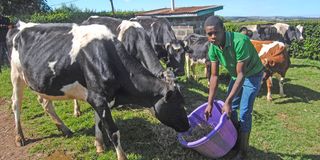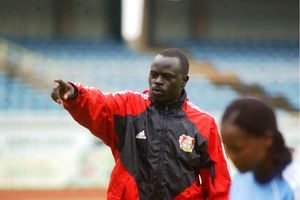Premium
Vet on call: Managing silent heat in dairy cattle

Collins Cheruiyot feeds his dairy cattle on a farm in Elburgon, Nakuru County. Dairy cattle raised in confinement often present farmers with many difficulties in heat detection.
What you need to know:
- Heat behaviour is a set of characteristics that a cow naturally exhibits to alert the bull that it is ready for mating.
- Cows on heat will have a reduction in milk yield due to reduced feeding and a lot of activity.
- Before a farmer declares her animals to be anoestrous, she should first ensure they have good body condition of between three and four on a 5-point body score.
- As a rule, animals seen on heat before noon must be inseminated before 4 pm. Those observed on heat in the afternoon are inseminated before 10 am the next day.
Farmers have from time immemorial used expression of heat to breed livestock and other animal species. Failure to express heat behaviour is one of the things that occasion losses to dairy farmers.
Heat behaviour is a set of characteristics that a cow naturally exhibits to alert the bull that it is ready for mating.
The behaviour is controlled by changes in the animal body where a set of bio-chemicals called hormones interact with the brain, the reproductive system and vocalisation. The heat cycle in a normal cow is 21 days on average.
It is rare that dairy cows on heat and in confinement will express all the heat signs. These include anxiety, watching over the fence, continuous vocalisation (mooing) and lack of concentration on feeding.
Some cows will initially mount others but when the animal is ready for mating, it will stand and allows others to mount it.
This is called standing heat and is the best time to inseminate the animal. There is also swelling of the vulva. At the time of standing heat, there is a discharge of clear fluid from the vulva.
Reduced feeding
Cows on heat will have a reduction in milk yield due to reduced feeding and a lot of activity.
Dairy cattle raised in confinement present farmers with many difficulties in heat detection. The stress of production, poor body condition and vitamin and mineral deficiencies are a common feature of confined dairy cattle where animals are not scientifically fed.
In my experience, almost all dairy cattle in confinement in Kenya are victims of one or more forms of deficiency.
They are also always in below-average body condition. This makes them candidates of either unexpressed or silent heat or they are anoestrous.
This week, I got an e-mail from Kingori in Nakuru. He said he had two dairy cattle that had failed to show heat
One cow gave birth a year ago and had never shown heat. The other is a three-year-old heifer that has remained silent.
The farmer said his local animal health service provider had recently treated the cows with hormones to induce heat without success. Each cow was injected with hormones every three days for 10 days.
The animals were inseminated on the 12th day but they never got pregnant. This was confirmed by pregnancy diagnosis three months from the date of insemination.
He wondered if the treatment was proper for his animals. He also wanted to know what he should do with his anoestrus cattle.
First, it is good to note that a large number of anoestrus dairy cattle in zero-grazing are actually silent cyclers.
They come on heat religiously every 21 days but the farmer never notices. The cause of the silent heat is either nutritional deficiencies or poor body condition. Only a small percentage of apparently anoestrus animals actually do not cycle.
Cycling status
Before a farmer declares her animals to be anoestrous, she should first ensure they have good body condition of between three and four on a 5-point body score.
This is where the cow’s last two ribs are slightly visible, the short ribs are well-covered with fat and the backbone is rounded.
The farmer should also ensure the animals have no signs of mineral deficiency. Animals with a good vitamin-mineral balance will have the natural hair colour for their breed.
Animals in poor body condition should be fed to raise the body condition score to the required level. They should also be fed vitamin-mineral supplements to correct any deficiencies observed.
If thereafter, they do not show heat, they should be presented to an animal health service provider for determination of their cycling status.
Silent heaters are easy to deal with. The animal health service provider diagnoses the cycling status and advises the farmer when the next heat is expected.
The farmer then observes the signs of heat twice per day, even if it is silent, and the animal is inseminated either in the morning or the afternoon depending on when the heat was detected.
As a rule, animals seen on heat before noon must be inseminated before 4 pm. Those observed on heat in the afternoon are inseminated before 10 am the next day.
Anoestrus cows are treated with hormones to rectify the body’s hormone imbalance that causes the failure to cycle. Several treatment methods are available.
The most common is the use of gonadotropin-releasing hormone (GnRH), which stimulates the production and release of a viable egg. Its use should be executed by a veterinary doctor.
I am not aware of any hormone that is administered in the sequence done on Kingori’s cows. I promised to assist him to sort out his problem.





